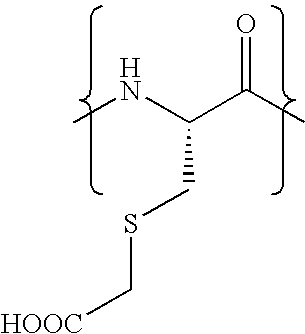Pseudo native chemical ligation
a chemical ligation and native technology, applied in the field of extending the technique of native chemical ligation, can solve the problems of solid-phase bound products, inability to achieve high-purity well-defined products, and inability to use recombinant dna techniques that are not universally successful,
- Summary
- Abstract
- Description
- Claims
- Application Information
AI Technical Summary
Benefits of technology
Problems solved by technology
Method used
Image
Examples
example 1
Synthesis of Synthetic Erythropoiesis Stimulating Protein SEP-0
[0226]A synthetic erythropoiesis stimulating protein (SEP) was synthesized. The sequence of the full-length synthesized protein (designated “SEP-0 (1–166)” is:
[0227]
(SEQ ID NO:1)APPRLTCDSR VLERYLLEAK EAEKITTGCA EHCSLNEKITVPDTKVNFYA WKRMEVGQQA VEVWQCLALL SEAVLRGQALLVKSSQPWψP LQLHVDKAVS GLRSLTTLLR ALGAQKψAISPPDAASAAPL RTITADTFRK LFRVYSNFLR GKLKLYTGEACRTGDR
[0228]where Ψ denotes a non-native amino acid residue consisting of a cysteine that is carboxymethylated at the sulfhydryl group. The SEP-0 protein was synthesized in solution from four polypeptide segments:
[0229]
Segment SEP-0:1 (GRFN 1711; composed of residues 1–32 of SEQ ID NO:1):APPRLICDSR VLERYLLEAK EAEKITTGCA EH-thioesterSegment SEP-0:2 (GRFN 1712, composed of residues 33–88 of SEQ ID NO:1):CSLNEKITVP DTKVNFYAWK RMEVGQQAVE VWQGLALLSE AVLRGQALLV KSSQPW-thioester(where Cys33 is Acm protected)Segment SEP-0:3 (GRFN 1713, composed of residues 89–116 of SEQ ID NO:1):CPLQLH...
example 2
Synthesis of Synthetic Erythropoiesis Stimulating Protein SEP-1-L30
[0240]A second synthetic erythropoiesis stimulating protein (designated SEP-1-L30) was synthesized to contain oxime-forming groups at positions 24 and 126 of SEP-0. These groups were then used to form SEP-1-L30, in which linear (EDA-Succ-)18 carboxylate (EDA=(4,7,10)-trioxatridecane-1,13diamine, also called TTD; Succ=—CO—CH2CH2CO—) polymers have been joined to the protein backbone. The sequence of the full-length SEP-1 (1–166) is:
[0241]
(SEQ ID NO:2)APPRLICDSR VLERYLLEAK EAEKoxITTGCA EHCSLNEKITVPDTKVNFYA WKRMEVGQQA VEVWQGLALL SEAVLRGQALLVKSSQPWψP LQLHVDKAVS GLRSLTTLLR ALGAQKψAISPPDAAKoxAAPL RTITADTFRK LFRVYSNFLR GKLKLYTGEACRTGDR
where Ψ denotes an non-native amino acid residue consisting of a cysteine that is carboxymethylated at the sulfhydryl group, and where Kox denotes a non-native lysine that is chemically modified at the ε-amino group with an oxime linker group coupled to a designated water-soluble polymer throug...
example 3
Synthesis of Synthetic Erythropoiesis Stimulating Protein SEP-1-L26
[0251]A third synthetic erythropoiesis stimulating protein (designated SEP-1-L26) was synthesized to contain oxime-forming groups at positions 24 and 126 of SEP-0. These groups were then used to form SEP-1-L26, in which the linear polymers (EDA-Succ)18 carboxylate and (EDA-Succ)6-amide have been joined to the protein backbone through oxime linkages at positions 24 and 126, respectively. The sequence of the full-length SEP-1 (1–166) is:
[0252]
(SEQ ID NO:2)APPRLICDSR VLERYLLEAK EAEKoxITTGCA EHCSLNEKITVPDTKVNFYA WKRMEVGQQA VEVWQGLALL SEAVLRGQALLVKSSQPWψP LQLHVDKAVS GLRSLTTLLR ALGAQKψAISPPDAAKoxAAPL RTITADTFRK LFRVYSNFLR GKLKLYTGEACRTGDR
where Ψ denotes an non-native amino acid residue consisting of a cysteine that is carboxymethylated at the sulfhydryl group, and where Kox denotes a non-native lysine that is chemically modified at the ε-amino group with an oxime linker group coupled to a designated water-soluble polymer t...
PUM
 Login to View More
Login to View More Abstract
Description
Claims
Application Information
 Login to View More
Login to View More - R&D
- Intellectual Property
- Life Sciences
- Materials
- Tech Scout
- Unparalleled Data Quality
- Higher Quality Content
- 60% Fewer Hallucinations
Browse by: Latest US Patents, China's latest patents, Technical Efficacy Thesaurus, Application Domain, Technology Topic, Popular Technical Reports.
© 2025 PatSnap. All rights reserved.Legal|Privacy policy|Modern Slavery Act Transparency Statement|Sitemap|About US| Contact US: help@patsnap.com



